Four Principles For Building Power in Media

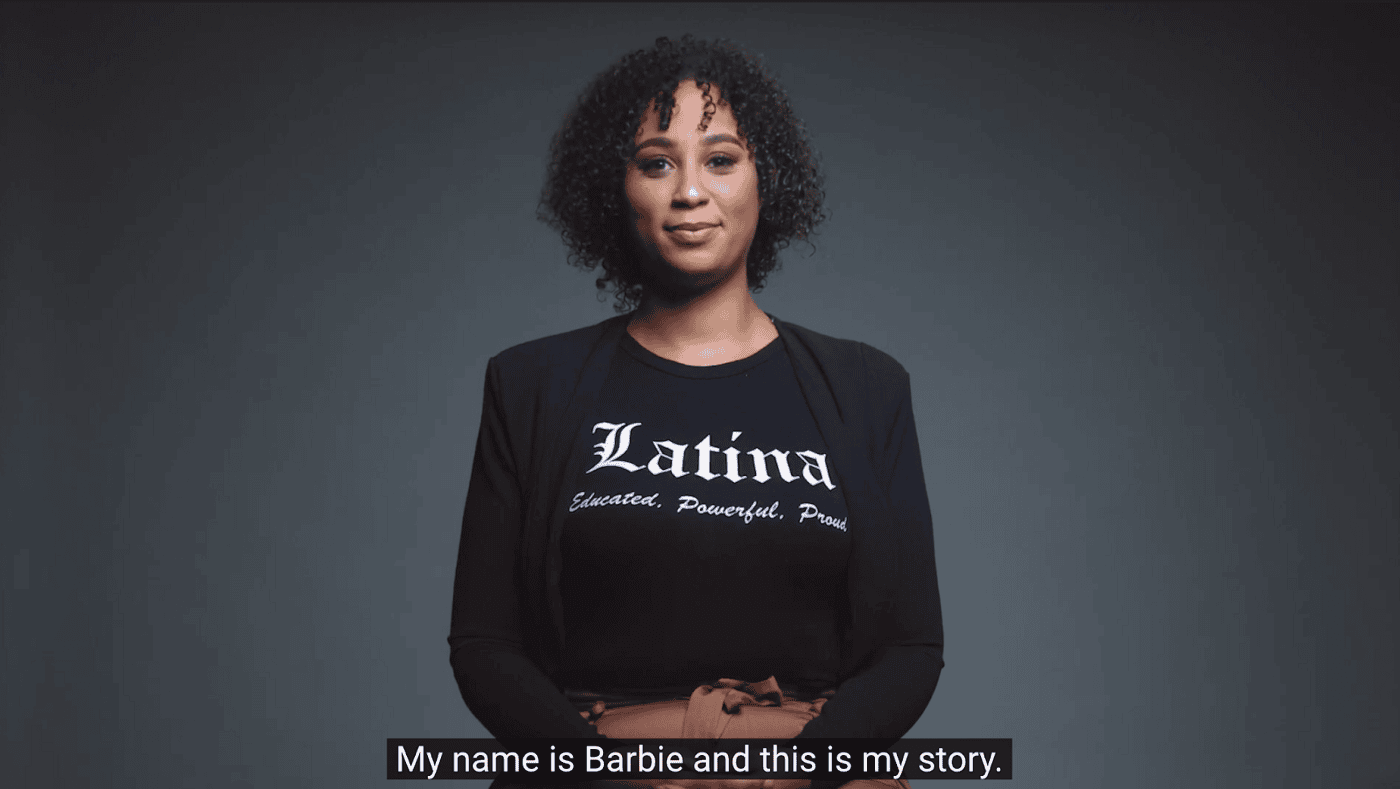
2022-03-14
“Welfare makes people lazy.”
Persistent narratives surrounding poverty and economic mobility are the result of story patterns that repeatedly reinforce those narratives. When audiences engage with stories in media, those stories can reinforce the themes present in other stories. Audiences repeatedly engaging with similar themes across different stories cause narratives to be born, and over time those narratives can reproduce, spread, and change. The Narrative Observatory @HarmonyLabs has identified eight distinct narratives about poverty and economic mobility. Story interventions are necessary to counteract the persistently problematic narratives and transform the public discussion about poverty so that a permanent solution can be achieved.
Women’s Way is a Philadelphia-based organization dedicated to the advancement of women, girls, and gender equity. In collaboration with Purpose, a social impact agency, and Harmony Labs, a media research lab, Women’s Way was interested in a specific inquiry: how to motivate individuals to recognize gender-based economic inequalities and take action to overcome them. If stories can persuade people, they were interested in knowing which stories work and told by whom.
Starting with the public narratives about poverty from the Narrative Observatory @Harmony Labs, this project focused on two specific narratives to inform the conception and execution of the storytelling intervention testing:
The Bill & Melinda Gates Foundation, whose funding paved the way for the creation of the Narrative Observatory and the analysis of narratives like those above, partnered with Harmony Labs and Purpose to support Women’s Way in staging a series of tests to answer the overarching hypothesis: Women telling real stories about their struggles to overcome financial hardships can influence people to believe in solutions for poverty.
To test this hypothesis, Women’s Way looked to understand how different stories about a woman with lived experience with economic insecurity might persuade audiences about ending poverty for good.
To do this, Harmony Labs and Purpose told the Women’s Way hypothesis through three lenses. The stories showed a woman, Barbie, talking about the path she took to get out of poverty:
A. Through Hard Work
B. Through Financial Literacy
C. Through Declaring Bankruptcy
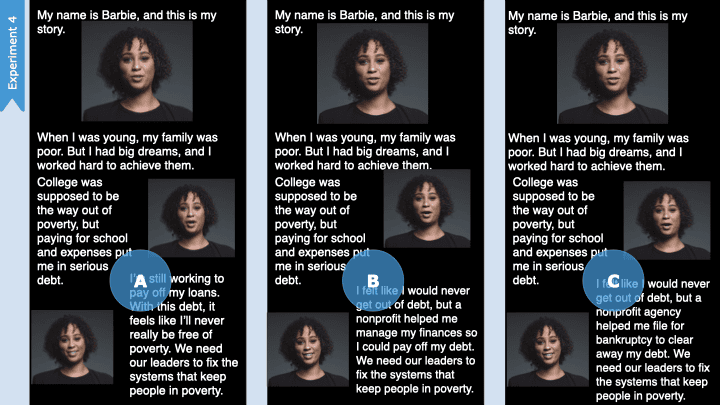
Harmony Lab then implemented a randomized controlled trial (RCT) to test the efficacy of these stories. About 1600 online respondents viewed one of these three stories, the test, or a piece of unrelated media, the control. They then took a survey indicating their level of agreement with three statements:
“Government has a responsibility to ensure that people can earn enough to get themselves out of poverty for good.”
“I can imagine how a world without poverty would work.”
“The best way to end poverty for good is to provide more support to those in need.”
We then conducted data analysis to compare the survey responses of online respondents who viewed the stories about Barbie to the people who viewed the unrelated control, which represents an audience’s baseline position. Through this analysis, we can tell if a piece of media “moved” an audience from their baseline.
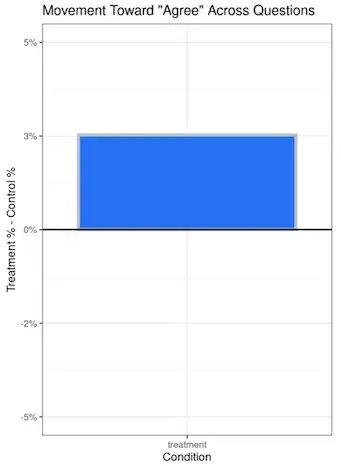
Key Result #1: The content affected people1. There was likely a positive impact overall from the story strips. Across the three versions of the story and all survey questions, there was an increase in agreement2. compared to the control.
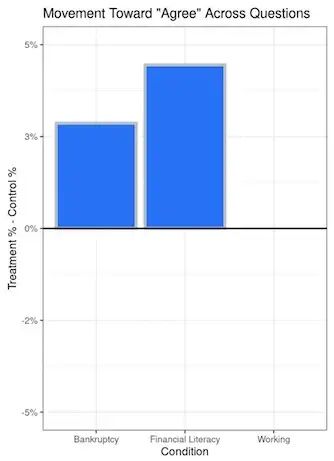
Key Result #2: Concrete interventions had a higher impact3. Both the “Financial Literacy” and “Bankruptcy” stories had positive effects4. The “Hard Work” story, which is most in line with the “Grind” narrative, had a vanishingly small impact. (Note the 2nd chart above — the “Hard Work” bar is on the graph, but is so small it does not reach beyond the axis.) This leads us to believe that a story about “more of the same,” just working harder, will probably not change audiences’ views about systemic solutions to poverty.
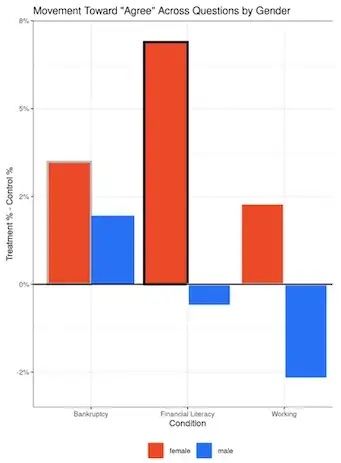
Key Result #3: Female and male audiences were persuaded differently5. The overall impact of these three stories is stronger for women, with the “Financial Literacy” story resulting in a statistically significant impact. Stories about women told by women appear to have a stronger impact on women, and they should be deployed with that differential impact in mind.
This test with Women’s Way, Purpose, and Harmony Labs is just one example of the ways to put the findings of the Narrative Observatory to work. In this instance, the three story options invited audiences to respond to common narratives (like “Not Like Us” or “The Grind”) that traditionally appear in public media — but by featuring an actual individual telling her lived experience, audiences were given an additional element to consider: person-to-person empathy and specific interventions beyond “hard work” that may help to eradicate poverty.
This suggests a tactic available to stage interventions in poverty narratives. Powerful stories can (and do) lead to concrete persuasion, and this insight offers possible routes for communications strategies for any organization with a mission of building economic mobility.
Although the work of narrative strategy happens at the level of audience and story, it is important to continually understand the entire narrative landscape to gauge how the stories we tell will land and affect audiences, and inform a data-driven approach to storytelling and content creation. Narratives in public media are ever-changing which means that this kind of work is never “finished.” If you are interested in staging a test like this one, or in the general work of audience and narrative intervention, please get in touch.
This blog is based on research funded in part by the Bill & Melinda Gates Foundation. The findings and conclusions contained within are those of the authors and do not necessarily reflect positions or policies of the Bill & Melinda Gates Foundation.
Gray border indicates a 90% confidence level ↩
90% confidence level ↩
Gray borders indicate a 90% confidence level ↩
90% confidence level ↩
Black border indicates a 95% confidence level. Gray border indicates a 90% confidence level. No borders indicate that statistical confidence is below the 90% level. ↩



